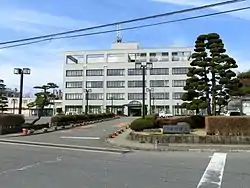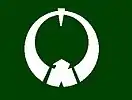Nasu, Tochigi
Nasu (那須町, Nasu-machi) is a town located in Tochigi Prefecture, Japan. As of 1 August 2020, the town had an estimated population of 24,851 in 10,400 households,[1] and a population density of 67 persons per km². The total area of the town is 372.34 square kilometres (143.76 sq mi).
Nasu
那須町 | |
|---|---|
 Nasu Town Office | |
 Flag  Seal | |
 Location of Nasu in Tochigi Prefecture | |
 Nasu | |
| Coordinates: 37°01′11.1″N 140°07′15.5″E | |
| Country | Japan |
| Region | Kantō |
| Prefecture | Tochigi Prefecture |
| District | Nasu |
| Area | |
| • Total | 372.34 km2 (143.76 sq mi) |
| Population (August 2020) | |
| • Total | 24,851 |
| • Density | 67/km2 (170/sq mi) |
| Time zone | UTC+9 (Japan Standard Time) |
| - Tree | Pine |
| - Flower | Gentian |
| - Bird | Common cuckoo |
| Phone number | 0287-72-6901 |
| Address | 3-13 Terakohei, Nasu-machi, Nasu-gun, Tochigi-ken 329-3222 |
| Website | Official website |
.jpg.webp)
Geography
Nasu is located in the mountainous far northeast of Tochigi Prefecture. The Naka River runs through the southwestern portion of the town and the Kurokawa River through the northeast.
Surrounding municipalities
- Ōtawara
- Nasushiobara
Climate
Nasu has a Humid continental climate (Köppen Cfa) characterized by warm summers and cold winters with heavy snowfall. The average annual temperature in Nasu is 11.4 °C. The average annual rainfall is 1406 mm with September as the wettest month. The temperatures are highest on average in August, at around 24.0 °C, and lowest in January, at around -0.2 °C.[2]
| Climate data for Nasu(Nasu Kogen, elevation 749m) | |||||||||||||
|---|---|---|---|---|---|---|---|---|---|---|---|---|---|
| Month | Jan | Feb | Mar | Apr | May | Jun | Jul | Aug | Sep | Oct | Nov | Dec | Year |
| Record high °C (°F) | 12.7 (54.9) |
15.3 (59.5) |
21.1 (70.0) |
26.8 (80.2) |
29.6 (85.3) |
30.3 (86.5) |
31.8 (89.2) |
32.2 (90.0) |
29.5 (85.1) |
24.6 (76.3) |
20.0 (68.0) |
17.4 (63.3) |
32.2 (90.0) |
| Average high °C (°F) | 1.7 (35.1) |
2.2 (36.0) |
6.0 (42.8) |
12.8 (55.0) |
17.5 (63.5) |
20.2 (68.4) |
23.7 (74.7) |
25.1 (77.2) |
21.0 (69.8) |
15.7 (60.3) |
10.6 (51.1) |
5.2 (41.4) |
13.5 (56.3) |
| Daily mean °C (°F) | −1.8 (28.8) |
−1.6 (29.1) |
1.6 (34.9) |
7.8 (46.0) |
12.6 (54.7) |
16.1 (61.0) |
19.8 (67.6) |
21.0 (69.8) |
17.1 (62.8) |
11.4 (52.5) |
6.1 (43.0) |
1.2 (34.2) |
9.3 (48.7) |
| Average low °C (°F) | −5.4 (22.3) |
−5.4 (22.3) |
−2.6 (27.3) |
2.8 (37.0) |
7.6 (45.7) |
12.1 (53.8) |
16.3 (61.3) |
17.4 (63.3) |
13.7 (56.7) |
7.4 (45.3) |
1.9 (35.4) |
−2.5 (27.5) |
5.3 (41.5) |
| Record low °C (°F) | −11.7 (10.9) |
−12.1 (10.2) |
−10.4 (13.3) |
−6.0 (21.2) |
−2.3 (27.9) |
3.6 (38.5) |
8.7 (47.7) |
8.9 (48.0) |
3.2 (37.8) |
−1.2 (29.8) |
−6.1 (21.0) |
−10.2 (13.6) |
−12.1 (10.2) |
| Average precipitation mm (inches) | 52.0 (2.05) |
51.8 (2.04) |
98.3 (3.87) |
136.3 (5.37) |
174.7 (6.88) |
220.5 (8.68) |
288.1 (11.34) |
319.3 (12.57) |
294.4 (11.59) |
177.6 (6.99) |
90.6 (3.57) |
52.9 (2.08) |
1,960.8 (77.20) |
| Average precipitation days (≥ 1.0 mm) | 10.9 | 9.9 | 12.0 | 11.6 | 12.4 | 16.1 | 18.4 | 17.0 | 15.3 | 11.1 | 9.1 | 8.9 | 152.7 |
| Mean monthly sunshine hours | 117.8 | 127.6 | 156.0 | 173.6 | 160.7 | 110.3 | 102.2 | 116.8 | 96.4 | 116.1 | 127.7 | 125.2 | 1,530.4 |
| Mean daily sunshine hours | 3.8 | 4.6 | 5.0 | 5.8 | 5.2 | 3.7 | 3.3 | 3.8 | 3.2 | 3.7 | 4.3 | 4.0 | 4.2 |
| Source 1: 理科年表 | |||||||||||||
| Source 2: Japan Meteorological Agency (Averages:1981-2010、Max-Min:1888-present)[3][4] | |||||||||||||
Demographics
Per Japanese census data,[5] the population of Nasu has remained relatively steadily over the past 40 years.
| Year | Pop. | ±% |
|---|---|---|
| 1920 | 20,064 | — |
| 1930 | 22,216 | +10.7% |
| 1940 | 23,069 | +3.8% |
| 1950 | 31,241 | +35.4% |
| 1960 | 30,359 | −2.8% |
| 1970 | 28,121 | −7.4% |
| 1980 | 26,824 | −4.6% |
| 1990 | 26,670 | −0.6% |
| 2000 | 27,027 | +1.3% |
| 2010 | 26,754 | −1.0% |
History
Nasu and Iouno villages and Ashino Town were created within Nasu District on April 1, 1889 with the creation of the modern municipalities system. The three municipalities merged to form Nasu Town on November 3, 1954. In March 2017 an avalanche killed 8 people.
Government
Nasu has a mayor-council form of government with a directly elected mayor and a unicameral town council of 13 members. Nasu, together with the city of Nasushiobara collectively contributes four members to the Tochigi Prefectural Assembly. In terms of national politics, the town is part of Tochigi 3rd district of the lower house of the Diet of Japan.
Economy
The economy of Nasu is heavily dependent on tourism from its numerous hot spring and ski resorts.
Education
Nasu has six public primary schools and two public middle schools operated by the town government. The town has one public high school operated by the Tochigi Prefectural Board of Education. There is also one private school including junior and high school.
Transportation
Highway
.png.webp) Tōhoku Expressway – Nasu Interchange, Nasu Kogen Service Area and Smart Interchange
Tōhoku Expressway – Nasu Interchange, Nasu Kogen Service Area and Smart Interchange National Route 4
National Route 4 National Route 294
National Route 294
Local attractions
- Nasu Highland (那須高原, Nasu kōgen)
- Nasu Onsen, the collective name given to the various hot springs in the Nasu area surrounding Mt. Chausu. The eight hot springs in this area with accommodation and bathing facilities are sometimes referred to as Nasu Hachiyu (那須八湯) (Shika no yu (鹿の湯), sandogoya onsen (三斗小屋温泉), ōmaru onsen (大丸温泉), kita onsen (北温泉), benten onsen (弁天温泉), takao onsen (高雄温泉), yahata onsen (八幡温泉), shin nasu onsen (新那須温泉)) [6]
- Ashio Onsen
- Sessho-seki
- Mount Nasu
- Nasu Animal Kingdom
- Mount Jeans Nasu Ski Resort, a ski resort to the far north of Nasu
- Nasu Rindō-ko Lake View (那須りんどう湖レイクビュー, Nasu rindō-ko reiku byū), an amusement facility based around the rindō lake, with activities such as a zip-line, boat ride, go-karts, and more.[7]
- Cannabis Museum
References
- "Nasu Town official home page" (in Japanese). Japan.
- Nasu climate data
- "平年値(年ごとの値)". Japan Meteorological Agency. Retrieved 2012-08-10.
- "観測史上1~10位の値(年間を通じての値)". Japan Meteorological Agency. Retrieved 2012-08-10.
- Nasu population statistics
- Nasu tourism guide. (in Japanese) Retrieved 24 February 2017.
- Nasu Rindō-ko Lake View (in Japanese) Retrieved 24 February 2017.